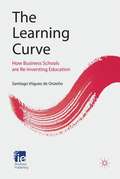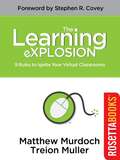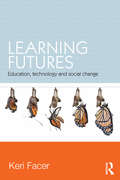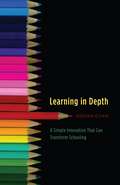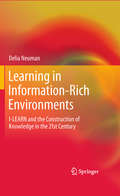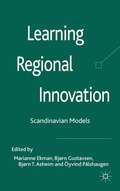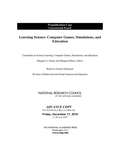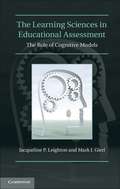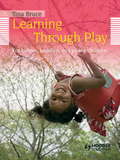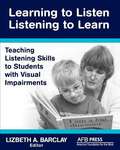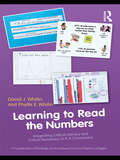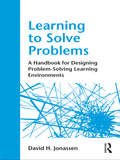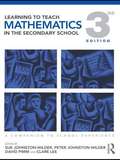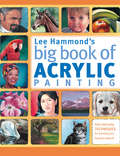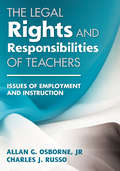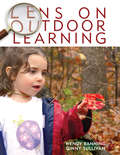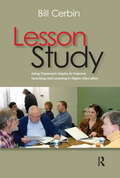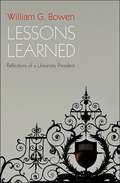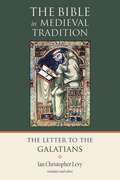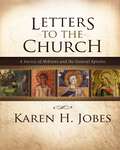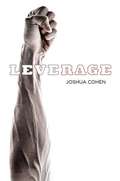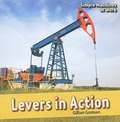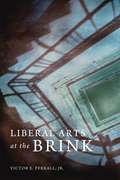- Table View
- List View
The Learning Curve
by Santiago Iniguez de OnzonoHow do you create world-class educational institutions that are academically rigorous and vocationally relevant? Are business schools the blueprint for institutions of the future, oran educational experiment gone wrong? This is thefirst title in a new series from IE Business School, IE Business Publishing .
The Learning Explosion
by Treion Muller Matthew MurdochMaking the move to online teaching and learning can be challenging, and professionals and laypeople alike want to know the best ways to accomplish the switchover without sacrificing the quality of the material that is being taught. The ultimate challenge is how one transfers the in-person teaching experience and to retain the quality of that experience in the online world in a way that maintains its original integrity. Ultimately what we want is an experience that is challenging and just as engaging as the experience one would get in a live classroom. This book helps readers learn how to transfer their in-person classroom experience and skills to the virtual classroom.
Learning Futures: Education, Technology and Social Change
by Keri FacerIn the twenty-first century, educators around the world are being told that they need to transform education systems to adapt young people for the challenges of a global digital knowledge economy. Too rarely, however, do we ask whether this future vision is robust, achievable or even desirable, whether alternative futures might be in development, and what other possible futures might demand of education. Drawing on ten years of research into educational innovation and socio-technical change, working with educators, researchers, digital industries, students and policy-makers, this book questions taken-for-granted assumptions about the future of education. Arguing that we have been working with too narrow a vision of the future, Keri Facer makes a case for recognizing the challenges that the next two decades may bring, including: the emergence of new relationships between humans and technology the opportunities and challenges of aging populations the development of new forms of knowledge and democracy the challenges of climate warming and environmental disruption the potential for radical economic and social inequalities. This book describes the potential for these developments to impact critical aspects of education – including adult-child relationships, social justice, curriculum design, community relationships and learning ecologies. Packed with examples from around the world and utilising vital research undertaken by the author while Research Director at the UK’s Futurelab, the book helps to bring into focus the risks and opportunities for schools, students and societies over the coming two decades. It makes a powerful case for rethinking the relationship between education and social and technological change, and presents a set of key strategies for creating schools better able to meet the emerging needs of their students and communities. An important contribution to the debates surrounding educational futures, this book is compelling reading for all of those, including educators, researchers, policy-makers and students, who are asking the question 'how can education help us to build desirable futures for everyone in the context of social and technological change?'
Learning in Depth: A Simple Innovation That Can Transform Schooling
by Kieran EganFor generations, schools have aimed to introduce students to a broad range of topics through curriculum that ensure that they will at least have some acquaintance with most areas of human knowledge by the time they graduate. Yet such broad knowledge can’t help but be somewhat superficial—and, as Kieran Egan argues, it omits a crucial aspect of true education: deep knowledge.Real education, Egan explains, consists of both general knowledge and detailed understanding, and in Learning in Depth he outlines an ambitious yet practical plan to incorporate deep knowledge into basic education. Under Egan’s program, students will follow the usual curriculum, but with one crucial addition: beginning with their first days of school and continuing until graduation, they will eachalso study one topic—such as apples, birds, sacred buildings, mollusks,circuses, or stars—in depth. Over the years, with the help and guidance of their supervising teacher, students will expand their understanding of their one topic and build portfolios of knowledge that grow and change along with them. By the time they graduate each student will know as much about his or her topic as almost anyone on earth—and in the process will have learned important, even life-changing lessons about the meaning of expertise, the value of dedication, and the delight of knowing something in depth.Though Egan’s program may be radical in its effects, it is strikingly simple to implement—as a number of schools have already discovered—and with Learning in Depth as a blueprint, parents, educators, and administrators can instantly begin taking the first steps toward transforming our schools and fundamentally deepening their students’ minds.
Learning in Information-Rich Environments
by Delia NeumanThe amount and range of information available to today's students--and indeed to all learners--is unprecedented. Phrases like "the information revolution", "the information (or knowledge) society", and "the knowledge economy" underscore the truism that our society has been transformed by virtually instantaneous access to virtually unlimited information. Thomas Friedman tells us that "The World Is Flat" and that we must devise new political and economic understandings based on the ceaseless communication of information from all corners of the world. The Bush administration tells us that information relating to the "war on terrorism" is so critical that we must allow new kinds of surveillance to keep society safe. Teenage subscribers to social-computing networks not only access information but enter text and video images and publish them widely--becoming the first adolescents in history to be creators as well as consumers of vast quantities of information. If the characteristics of "the information age" demand new conceptions of commerce, national security, and publishing--among other things--it is logical to assume that they carry implications for education as well. In fact, a good deal has been written over the last several decades about how education as a whole must transform its structure and curriculum to accommodate the possibilities offered by new technologies. Far less has been written, however, about how the specific affordances of these technologies--and the kinds of information they allow students to access and create--relate to the central purpose of education: learning. What does "learning" mean in an information-rich environment? What are its characteristics? What kinds of tasks should it involve? What concepts, strategies, attitudes, and skills do educators and students need to master if they are to learn effectively and efficiently in such an environment? How can researchers, theorists, and practitioners foster the well-founded and widespread development of such key elements of the learning process? This book explores these questions and suggests some tentative answers. Drawing from research and theory in three distinct but related fields--learning theory, instructional systems design, and information studies--it presents a way to think about learning that responds directly to the actualities of a world brimming with information. The book is grounded in the work of such key figures in learning theory as Bransford and Anderson & Krathwohl. It draws on such theorists of instructional design as Gagne, Mayer, and Merrill. From information studies, it uses ideas from Buckland, Marchionini, and Wilson (who is known for his pioneering work in "information behavior"--that is, the full range of information seeking and use). The book breaks new ground in bringing together ideas that have run in parallel for years but whose relationship has not been fully explored.
Learning Regional Innovation
by Marianne Ekman Bj�rn Gustavsen Bj�rn T. Asheim �yvind P�lshaugenParticipation and social responsibility in innovation is the core theme of this book. Both are issues of organization and not of ethics, or the enforcement of other forms of obligations on individual actors. The need is for a democratization of innovation that can make innovation open to broad participation.
Learning Science Through Computer Games and Simulations
by National Research Council of the National AcademiesAt a time when scientific and technological competence is vital to the nation's future, the weak performance of U.S. students in science reflects the uneven quality of current science education. Although young children come to school with innate curiosity and intuitive ideas about the world around them, science classes rarely tap this potential. Many experts have called for a new approach to science education, based on recent and ongoing research on teaching and learning. In this approach, simulations and games could play a significant role by addressing many goals and mechanisms for learning science: the motivation to learn science, conceptual understanding, science process skills, understanding of the nature of science, scientific discourse and argumentation, and identification with science and science learning. To explore this potential, Learning Science: Computer Games, Simulations, and Education, reviews the available research on learning science through interaction with digital simulations and games. It considers the potential of digital games and simulations to contribute to learning science in schools, in informal out-of-school settings, and everyday life. The book also identifies the areas in which more research and research-based development is needed to fully capitalize on this potential. Learning Science will guide academic researchers; developers, publishers, and entrepreneurs from the digital simulation and gaming community; and education practitioners and policy makers toward the formation of research and development partnerships that will facilitate rich intellectual collaboration. Industry, government agencies and foundations will play a significant role through start-up and ongoing support to ensure that digital games and simulations will not only excite and entertain, but also motivate and educate.
The Learning Sciences in Educational Assessment
by Mark J. Gierl Jacqueline P. LeightonThere is mounting hope in the United States that federal legislation in the form of No Child Left Behind will improve educational outcomes. As titanic as the challenge appears to be, however, the solution could be at our fingertips. This volume identifies visual types of cognitive models in reading, science and mathematics for researchers, test developers, school administrators, policy makers and teachers. In the process of identifying these cognitive models, the book also explores methodological or translation issues to consider as decisions are made about how to generate psychologically informative and psychometrically viable large-scale assessments based on the learning sciences. Initiatives to overhaul educational systems in disrepair may begin with national policies, but the success of these policies will hinge on how well stakeholders begin to rethink what is possible with a keystone of the educational system: large-scale assessment.
Learning Through Play
by Tina BruceProfessor Tina Bruce CBE, an acknowledged expert on play, clearly presents the key ideas and demonstrates the best practices for cultivating play in an Early Years setting. The book covers historical perspectives, how we can observe and study play, and the role of play in learning, developing abstract ideas, helping children to relate to one another. She shows that play helps children to achieve the highest form of learning in early childhood. This new edition of Learning Through Play will provide students and practitioners with an invaluable guide to the core values behind play, the importance of play for children from 0 to 5 years old, and practical schemas for getting the best out of play in an Early Years or Educational setting. It will be an ideal text for those studying play at levels 3 and 4, Foundation Degrees, Undergraduate Early Childhood Studies and Primary Education courses, Post-graduate study and for those working in an Early Years setting.
Learning to Listen/Listening to Learn
by Lizbeth A. BarclayLearning to Listen/Listening to Learn is the first comprehensive work to address the systematic development of skills in listening for and interpreting auditory information for students who are blind or visually impaired. Listening skills are a crucial but often-overlooked area of instruction for children who are visually impaired and may have multiple disabilities, essential to literacy, independent travel, and sensory and cognitive development. Chock full of practical strategies, this volume examines the development of and instruction in learning skills at different ages, from infancy through high school. It also addresses listening skills in orientation and mobility and the needs of children with multiple disabilities, hearing impairment, and learning disabilities, as well as English language learners. Appendixes provide a Listening Skills Continuum chart and a checklist to use in assessment.
Learning to Read the Numbers: Integrating Critical Literacy and Critical Numeracy in K-8 Classrooms. A Co-Publication of The National Council of Teachers of English and Routledge
by David J. Whitin Phyllis E. WhitinBeing a critical reader of numerical information is an integral part of being literate in today’s data-drenched world. Uniquely addressing both mathematics and language issues, this text shows how critical readers dig beneath the surface of data to better evaluate their usefulness and to understand how numbers are constructed by authors to portray a certain version of reality. Engaging, concise, and rich with examples and clear connections to classroom practice, it provides a framework of critical questions that children and teachers can pose to crack open authors’ intentions, expose their decisions, and make clear who are the winners and losers – questions that are essential for building democratic classrooms. Explaining and illustrating how K-8 teachers can engage students in developing the ability to be both critical composers and critical readers of texts, Learning to Read the Numbers is designed for teacher education courses across the areas of language arts, mathematics, and curriculum studies, and for elementary teachers, administrators, and literacy and mathematics coaches. Learning to Read the Numbers is a co-publication of The National Council of Teachers of English (www.ncte.org) and Routledge.
Learning to Solve Problems: A Handbook for Designing Problem-Solving Learning Environments
by David H. JonassenThis book provides a comprehensive, up-to-date look at problem solving research and practice over the last fifteen years. The first chapter describes differences in types of problems, individual differences among problem-solvers, as well as the domain and context within which a problem is being solved. Part one describes six kinds of problems and the methods required to solve them. Part two goes beyond traditional discussions of case design and introduces six different purposes or functions of cases, the building blocks of problem-solving learning environments. It also describes methods for constructing cases to support problem solving. Part three introduces a number of cognitive skills required for studying cases and solving problems. Finally, Part four describes several methods for assessing problem solving. Key features includes: Teaching Focus – The book is not merely a review of research. It also provides specific research-based advice on how to design problem-solving learning environments. Illustrative Cases – A rich array of cases illustrates how to build problem-solving learning environments. Part two introduces six different functions of cases and also describes the parameters of a case. Chapter Integration – Key theories and concepts are addressed across chapters and links to other chapters are made explicit. The idea is to show how different kinds of problems, cases, skills, and assessments are integrated. Author expertise – A prolific researcher and writer, the author has been researching and publishing books and articles on learning to solve problems for the past fifteen years. This book is appropriate for advanced courses in instructional design and technology, science education, applied cognitive psychology, thinking and reasoning, and educational psychology. Instructional designers, especially those involved in designing problem-based learning, as well as curriculum designers who seek new ways of structuring curriculum will find it an invaluable reference tool.
Learning to Teach Mathematics in the Secondary School: A Companion to School Experience
by David Pimm Sue Johnston-Wilder Clare LeeWhat is the role of mathematics in the secondary classroom? What is expected of a would-be maths teacher? How is mathematics best taught and learnt? Learning to Teach Mathematics in the Secondary School combines theory and practice to present a broad introduction to the opportunities and challenges of teaching mathematics in the modern secondary school classroom. Written specifically with the new and student teacher in mind, the book covers a wide range of issues related to the teaching of mathematics, including: The role of ICT Assessment for Learning NEW Using mathematics in context NEW Communicating mathematically Planning mathematics lessons Including special-needs pupils Teaching mathematics post-16 Professional Development Already a major text for many university teaching courses, this fully revised third edition takes into account new developments in the National Curriculum as well as recent changes to the standards for Qualified Teacher Status. Featuring two brand new chapters, a glossary of useful terms, addresses for resources and organisations, and tasks designed to prompt critical reflection and support thinking and writing at Masters level, this book will help you make the most of school experience, during your training and beyond. Designed for use as a core textbook, this new edition of Learning to Teach Mathematics in the Secondary School provides essential guidance and advice for all trainee and practising teachers of secondary mathematics.
Lee Hammond's Big Book of Acrylic Painting: Fast, easy techniques for painting your favorite subjects
by Lee HammondBasic Acrylic Instruction-Amazing Results! This resource is packed with the best of Lee Hammond's lessons and tips on working with acrylics, including more than 80 step-by-step exercises and demonstrations that will have you creating amazing paintings in no time flat. Success is easy-just follow along with Lee! With just seven to nine pigments, you can paint anything. You'll learn how to add layers and details, one stroke at a time. Along the way, Lee 's friendly encouragement and quick tips will help you work past what she calls "the awkward stage," so you can complete your paintings with confidence. In addition to detailed information on selecting materials and mixing colors, you'll also get complete visual instruction for painting subjects of all kinds, including: Still Life: Get proper proportions every time, using easy graphing techniques. You'll also find demonstrations for painting the tricky parts, such as glossy textures and reflective surfaces. Landscapes: Lee shares proven tips for creating depth and realism in subjects ranging from forests and mountains to prairies and seascapes. She also shows how to paint realistic clouds, trees, water and more. Animals: This chapter provides step-by-step guidance for painting all your favorite creatures. There's even extra instruction for getting the eyes, noses, fur and feathers just right. People: Painting people can be especially challenging, but success is easy with basic steps and practical guidance. One feature at a time, you'll learn simple techniques for painting faces of all kinds-male or female, young or old. You'll also find in-depth guidance for creating realistic fleshtones, eye color, hair and more. This is a complete acrylic painting course right on your bookshelf. Follow along from beginning to end or refer to this guide when you need a quick lesson. Either way, after learning from a master like Lee Hammond, you won't be a beginner for long. Get started today!
Leetong: UBC contracted
by S. Machabe MofokengDipalekgutshwe tse ngotsweng bukeng ke tse hlokang hore mmadi a tsitsise maikutlo ha a dibala. A be le mamello a inkele thuto ya bohlokwa ho tsona. Di ruta ka mathata a bophelo. Empa qetellong di hlalosa hore pheletso ya motho e diatleng tsa mmopi wa hae. These short stories make the reader deepen his thoughts and feelings. He needs to be patient and understand the morals in them.
Leetong: UBC uncontracted
by S. Machabe MofokengDipalekgutshwe tse ngotsweng bukeng ke tse hlokang hore mmadi a tsitsise maikutlo ha a dibala. A be le mamello a inkele thuto ya bohlokwa ho tsona. Di ruta ka mathata a bophelo. Empa qetellong di hlalosa hore pheletso ya motho e diatleng tsa mmopi wa hae. These short stories make the reader deepen his thoughts and feelings. He needs to be patient and understand the morals in them.
The Legal Rights and Responsibilities of Teachers: Issues of Employment and Instruction
by Dr Allan G. Osborne Dr Charles J. RussoEverything teachers need to know about education law Do you know what you can and can’t say and do in your school? Most teacher education programs offer little, if any, instruction on education law. When teachers need advice regarding employment or instructional issues, they may find the search frustrating, time-consuming, or costly. Teachers will find the answers to their most frequently asked legal questions in this easy-to-read book. Key topics include: Certification, tenure, evaluation, and dismissal Collective bargaining and teacher contracts Constitutional rights of teachers Discrimination and harassment Teachers’ responsibility regarding student bullying Academic freedom Copyright law Safety
Lens on Outdoor Learning
by Wendy Banning Ginny SullivanThe outdoors is full of rich learning experiences for preschool and pre-kindergarten children. Lens on Outdoor Learning is filled with stories and colorful photographs that illustrate how the outdoors supports children's early learning. Each story is connected to an early learning standard such as curiosity and initiative; engagement and persistence; imagination, invention, and creativity; reasoning and problem-solving; risk-taking, responsibility, and confidence; reflection, application, and interpretation; and flexibility and resilience. Much of the teaching in these experiences is indirect and involves provisioning, observing, and conversing with children as they spend quality time in nature. Children's dialogue and actions are included in each story to show just how engaged they became during these experiences. Lens on Outdoor Learning will inspire early childhood professionals to use this outdoor approach in their own setting.Wendy Banning is coordinator of Irvin Learning Farm, an inquiry-based, hands-on outdoor learning space for children and adults in North Carolina. She is also an educational consultant, teacher, trainer, and photographer.Ginny Sullivan is co-principal of Learning by the Yard, a partnership of landscape architects and educators that helps schools develop their grounds as habitat, focusing on native plants. Ginny consults, trains teachers, and involves schools and centers in the design of their outdoor spaces to help children learn about the natural world.
Lesson Study: Using Classroom Inquiry to Improve Teaching and Learning in Higher Education
by Bill CerbinWhy do students stumble over certain concepts and ideas—such as attributing causality to correlation; revert to former misconceptions, even after successfully completing a course—such as physics students continuing to believe an object tossed straight into the air continues to have a force propelling it upward; or get confused about terminology—such as conflating negative reinforcement with punishment?This is the first book about lesson study for higher education. Based on the idea that the best setting in which to examine teaching is where it takes place on a daily basis—the lecture hall, seminar room, studio, lab, and the online classroom management system – lesson study involves several instructors jointly designing, teaching, studying, and refining an individual class lesson in order to explore student learning problems, observe how students learn, and analyze how their instruction affects student learning and thinking. The primary purpose is to help teachers better understand how to support student learning and thinking. By observing how students learn through lesson study teachers can improve their own teaching and build knowledge that can be used by other teachers to improve their practice.Lesson study grew out of the collective efforts of classroom teachers in Asia—most notably in Japan—to improve their teaching. Subsequently imported, tested, and implemented by a group of instructors of biology, economics, English, and psychology at the University of Wisconsin-La Crosse, the process proved so valuable that the university has since established the College Lesson Study Project, of which the author of this book is Director.Focusing on a single lesson enables participants to examine in detail every step of the teaching process, from vision and goals, to instructional design, to implementation, to observation and analysis of student performance, and then evidence-based improvement. It enables faculty to explore learning problems that matter most to them, learn alternative ways to teach from one another, and co-design new course materials.This book introduces lesson study practices to college teachers, providing the necessary guidance, tools, examples, models, and ideas to enable teachers to undertake lesson study in their own classes. It also explores the underlying rationale for lesson study practices and how to realize the full potential of lesson study to advance teaching and learning.A Joint Publication with the National Teaching and Learning ForumAn ACPA / NASPA Joint Publication
Lessons Learned: Reflections of a University President
by William G. BowenLessons Learnedgives unprecedented access to the university president's office, providing a unique set of reflections on the challenges involved in leading both research universities and liberal arts colleges. In this landmark book, William Bowen, former president of Princeton University and of the Andrew W. Mellon Foundation, and coauthor of the acclaimed best-sellerThe Shape of the River, takes readers behind closed faculty-room doors to discuss how today's colleges and universities serve their age-old missions. With extraordinary candor, clarity, and good humor, Bowen shares the sometimes-hard lessons he learned about working with trustees, faculty, and campus groups; building an effective administrative team; deciding when to speak out on big issues and when to insist on institutional restraint; managing dissent; cultivating alumni and raising funds; setting academic priorities; fostering inclusiveness; eventually deciding when and how to leave the president's office; and much more. Drawing on more than four decades of experience, Bowen demonstrates how his greatest lessons often arose from the missteps he made along the way, and how, when it comes to university governance, there are important general principles but often no single right answer. Full of compelling stories, insights, and practical wisdom,Lessons Learnedframes the questions that leaders of higher education will continue to confront at a complex moment in history.
The Letter to the Galatians (Medieval Bible Commentary series)
by Ian Christopher LevyThis work on Galatians is the inaugural volume in a significant new commentary series, The Bible in Medieval Tradition, which seeks to reconnect today's Christians with part of the church's rich tradition of biblical interpretation. Ian Christopher Levy has brought together six substantial commentaries on Galatians written between the ninth and the fourteenth centuries. Levy's clear, readable translations of these major texts -- previously unavailable in English -- are augmented by his in-depth introduction, which locates each author within the broad context of medieval scholarship.
Letters to the Church: A Survey of Hebrews and the General Epistles
by Karen H. JobesRespected New Testament scholar Karen Jobes explores the cultural and theological background of Hebrews and the general epistles (James through Jude) in this rich commentary. Writing from an evangelical perspective, Jobes addresses issues of historical relevance as well as how these ancient books connect with Christian faith and practice today. Letters to the Church includes: -Historical background for each book focusing on authorship, genre, date, and content -An exploration of the major themes in each book and detailed commentary on key passages -Boxes with chapter goals, outlines, challenges, and significant verses -Sidebars addressing difficult passages or ideas -Maps, photographs, charts, and definitions -Questions for discussion, reflection, and testing -A comparison of the teachings about Christ in each of the letters Pastors, professors, students, and laypeople interested in deeper biblical study will find this an invaluable resource that offers well-researched commentary in an accessible, spiritually meaningful form.
Leverage
by Joshua CohenThe football field is a battlefield There's an extraordinary price for victory at Oregrove High. It is paid on and off the football field. And it claims its victims without mercy including the most innocent bystanders. When a violent, steroid-infused, ever-escalating prank war has devastating consequences, an unlikely friendship between a talented but emotionally damaged fullback and a promising gymnast might hold the key to a school's salvation. Told in alternating voices and with unapologetic truth, Leverage illuminates the fierce loyalty, flawed justice, and hard-won optimism of two young athletes.
Levers In Action (Simple Machines at Work)
by Gillian GosmanLevers are everywhere. Readers will learn about historical and present-day uses of levers and how levers make countless everyday activities much easier. A simple experiment is included with step-by-step instructions.
Liberal Arts at the Brink
by Victor E. FerrallLiberal arts colleges represent a tiny portion of the higher education market—no more than 2 percent of enrollees. Yet they produce a stunningly large percentage of America’s leaders in virtually every field of endeavor. The educational experience they offer—small classes led by professors devoted to teaching and mentoring, in a community dedicated to learning—has been a uniquely American higher education ideal. Liberal Arts at the Brink is a wake-up call for everyone who values liberal arts education. A former college president trained in law and economics, Ferrall shows how a spiraling demand for career-related education has pressured liberal arts colleges to become vocational, distorting their mission and core values. The relentless competition among them to attract the “best” students has driven down tuition revenues while driving up operating expenses to levels the colleges cannot cover. The weakest are being forced to sell out to vocational for-profit universities or close their doors. The handful of wealthy elite colleges risk becoming mere dispensers of employment and professional school credentials. The rest face the prospect of moving away from liberal arts and toward vocational education in order to survive. Writing in a personable, witty style, Ferrall tackles the host of threats and challenges liberal arts colleges now confront. Despite these daunting realities, he makes a spirited case for the unique benefits of the education they offer—to students and the nation. He urges liberal arts colleges to stop going it alone and instead band together to promote their mission and ensure their future.
